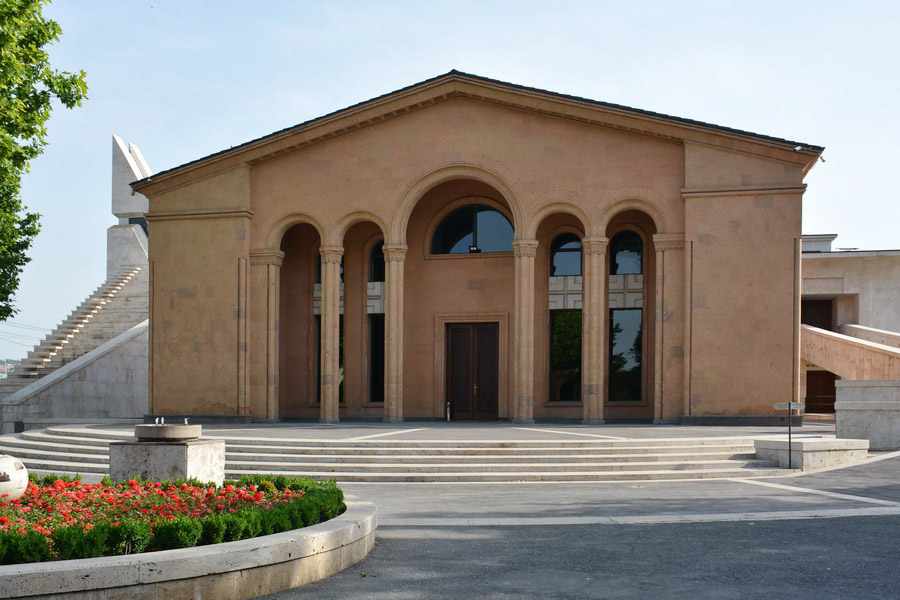
Address: 28, Arshakunyats Str., Yerevan
Phone: (+374 11) 57-05-70
Working hours: daily from 10:00 a.m. till 04:30 p.m.
Closed: on Wednesday
Komitas Museum-Institute in Yerevan is dedicated to the life and work of Armenia’s greatest composer, singer, choirmaster, folklorist, explorer, researcher and ecclesiastical figure - Soghomon Soghomonian, better known as Komitas.
Komitas has been the inspiration for countless Armenian musicians, yet he is also revered far beyond the borders of his native country, for his works and tireless efforts to preserve Armenia’s musical heritage have elevated Armenian music to worldwide fame. The opinion of international musicians toward Komitas was best summarized during a 1906 concert in Paris at which eminent French composer Claude Debussy knelt in front of Komitas, kissed his hand and hailed him a genius. Debussy later declared that Komitas could be regarded a brilliant composer based solely on his work "Song of the Wanderer".
One of the most important cultural centers in Armenia’s capital, Komitas Museum-Institute offers visitors a genuinely beautiful experience of his many masterpieces and an emotional glimpse into the bittersweet life of the brilliant composer.
Life of Komitas
Soghomon Soghomonian was born in 1869 in Kutahya of the Ottoman Empire, in present-day Turkey. His parents were known throughout Kutahya for their exquisite voices, and the songs which they composed were adored by locals. Soon after the composer’s birth, however, his parents passed away, leaving relatives to raise the orphaned Komitas.
Although he lost his parents at a young age, Komitas inherited their musical talent, a fact which did not go unnoticed by his caretakers. As a young adult, he moved to Armenia and enrolled in Gevorgian Seminary in Etchmiadzin. Between 1895-1896 Komitas lived in Tiflis (Georgia) and learned the principles of harmony from composer Makar Yekmalyan. Komitas continued his studies in Germany, earning a degree from the Department of Philosophy of Frederick William University. Shortly thereafter he became a founding member of the newly established International Music Society, through which he actively promoted Armenian music at international conferences.
The works that Komitas created in Germany were invaluable and included much harmonization of liturgy, choruses on German poetry and his original song “By the Rivers of Babylon”. Many of his songs and choruses were based on Armenian motifs.
Komitas also compiled thousands of pieces of Armenian folk music, and thanks to his hard work and dedication, succeeding generations have been instilled with pride for Armenian culture as they enjoy these songs. As a result of his contributions, Komitas is now regarded as the most notable composer in Armenia.
In 1910, Komitas moved to Constantinople (now Istanbul) to continue his career. Yet when the Armenian genocide began in 1915, the life of Komitas and of millions of his countrymen was changed forever. Along with many other notable Armenians, Komitas was arrested and exiled to northern Anatolia. Mehmet Emin Yurdakul, a Turkish poet and friend of Komitas, joined together with U.S. ambassador Henry Morgenthau to advocate for the return of Komitas to Constantinople. Although their appeals were successful, the acts of violence that the composer had witnessed had an irreversible effect on his mental health. He was taken to psychiatric clinics, first in Constantinople and then in Paris, but his gentle soul never recovered. In 1935, Komitas passed away in France at the age of 66. His ashes were taken to Yerevan, where they are buried in the Komitas Pantheon.
Visiting the Museum
Komitas Museum-Institute is relatively new, having been established in 2015 on the initiative of President Serzh Sargsyan to commemorate the beloved composer’s legacy and impact on the development of Armenian music. Designed by architect Arthur Meschian, the building includes a concert hall, permanent and temporary exhibitions, library, research center, music studio and a publishing house. Exhibition halls present a chronological view of the life and works of Komitas, beginning with his early years and ending with his final legacy. The music of Komitas gently reverberates throughout the exhibition halls, bringing the tour experience to a whole new level. English-speaking guides are also available.
Komitas Museum-Institute in Yerevan offers a moving and worthwhile experience to anyone with an appreciation for music and Armenian culture and history. The museum is situated near Komitas Pantheon inside Komitas Park, located on the right-hand side of central Arshakunyats Avenue. It is open from 10am until 4pm every day but Wednesday.

